| 150-400mm |
$7,500 average price |
|---|---|
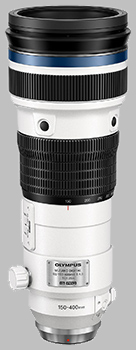
|
|
Your purchases support this site
Buy the Olympus 150-400mm f/4.5 TC1.25x IS PRO M.Zuiko
Elevate your bird photography with these 8 tips and techniques |
| Note: Please be aware that while Olympus sponsored this project, we conceived of the piece in its entirety, wrote the script, and were given complete editorial freedom throughout the process. |
• • •
Olympus 150-400mm f/4.5 TC1.25x IS PRO Field Test
Olympus' long-awaited professional supertelephoto zoom knocks it out of the park, but it'll cost you.
by William Brawley | Posted 11/17/2020
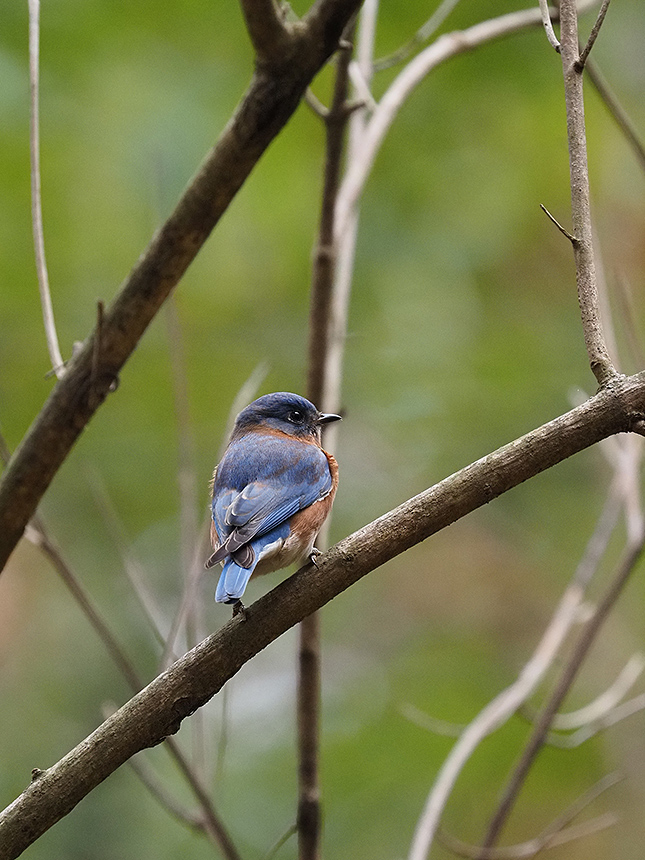 |
E-M1X: 483mm (877mm eq.), f/5.6, 1/800s, ISO 2500 (JPEG cropped slightly) |
One of the primary reasons I enjoy shooting with Olympus cameras -- and the Micro Four Thirds platform in general -- is the portability that the system offers, especially when it comes to telephoto and supertelephoto lenses. Combine that with the rugged weather-sealing and excellent build quality of Olympus' OM-D system, and you have one of my all-time favorite setups for any nature and wildlife photography outings. The image quality from this setup ain't half-bad, either. In fact, it's very impressive in most situations, so long as you keep the ISO level in check (which is admittedly one of the weak spots, comparatively, against other camera systems with larger sensors).
A few years ago, Olympus wowed the wildlife world with the 300mm f/4 IS PRO lens. Providing a 600mm-equivalent focal length, amazing image stabilization and tack-sharp image quality all in a hand-holdable package, the 300mm f/4 PRO was arguably one of Olympus' most impressive lenses yet -- easily winning Best Telephoto Prime Lens in our 2016 Lens of the Year Awards. Nature photographers could now get that crucial long telephoto reach but in a lens that was downright minuscule compared to the full-frame 600mm f/4 competitors. Plus, it was a fraction of the cost as well. It was, and is, a great lens if you want reach and mobility.
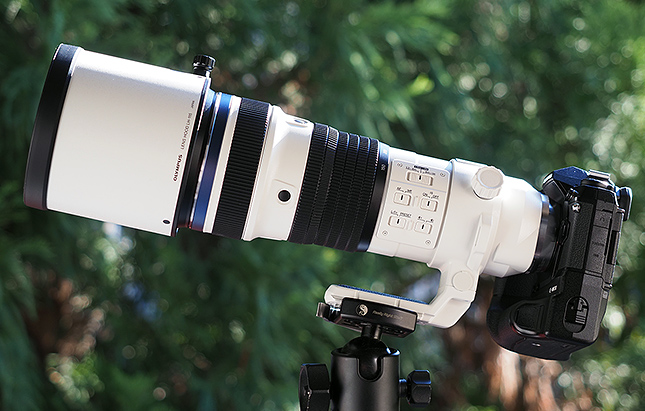 |
Yet now, Olympus has pulled out all the stops and finally unveiled the ultimate wildlife and nature supertelephoto lens: the 150-400mm f/4.5 TC1.25x IS PRO. Teased as a development project all the way back at CP+ in 2019, the new Olympus 150-400mm Pro lens is by far Olympus' most high-end, most professionally-oriented lens yet for the M.Zuiko Micro Four Thirds lens family. Built in Japan, the new supertelephoto zoom feels like a "spared-no-expense" affair, offering an exotic array of optical elements, a rugged magnesium alloy construction, faster AF performance and, as the name suggests, a built-in teleconverter -- a first for an Olympus lens.
As one might expect, this ultimate telephoto zoom lens does not come cheap. With an MSRP of $7,499 it's by far Olympus' most expensive modern lens to date. But before that scares you away, consider the competition. Top-of-the-line supertelephoto zooms, such as the Canon 200-400mm f/4L IS 1.4x and the Nikon 180-400mm f/4E TC1.4 for example, both offer a similar versatile long zoom range, constant aperture design, house a built-in teleconverter mechanism and feature the respective brands' best optical design and build quality. However, both of these particular lenses are significantly heavier, bulkier and ding the bank account to the tune of $11,000-12,000. So while yes, the new Olympus 150-400mm is indeed a serious investment, it's relatively affordable within the professional supertelephoto lens category.
 |
E-M1X: 500mm (1000mm eq.), f/5.6, 1/1000s, ISO 1600, 1.25x TC |
IR was given a rare early look at one of the first production-grade samples of the new Olympus 150-400mm f/4.5 Pro lens, and I've spent the last couple of weeks shooting with it paired up with the E-M1X. (Note: Although Olympus also announced a new firmware update for the E-M1X that adds Bird-detection AF to its unique, AI-based Intelligent Subject Detection system, the firmware has yet to be released. Images here in this Field Test were shot with the E-M1X with its most up-to-date currently-available firmware. Needless to say, though, I can't wait to try the E-M1X with Bird Detection AF and this lens!)
Let's dive into the details about how Olympus' long-awaited super-pro, super-telephoto zoom lens handles in the field.
Key Features & Specs
- 150-400mm focal length range (300-800mm eq. in 35mm terms)
- Constant f/4.5 aperture
- Built-in 1.25x teleconverter: ~188-500mm f/5.6 (~376-1000mm eq. in 35mm terms)
- Compatible with Olympus 1.4x and 2.0x teleconverters for up to 2000mm-eq. focal length reach
- Optical Image Stabilization with up to 4.5 stops
- Up to 8 stops I.S. at 150mm, 6 stops at 500mm with Sync IS (E-M1X, E-M1 III)
- Weather-sealed construction (IPX1-rated)
- Off-white paint and head-shielding coating to reduce internal heat & heat-related optical distortions
- Lightweight build with mag-alloy lens barrel, carbon fiber lens hood
- 4.13lbs (1875g) weight
- Can fit into airline carry-on bag
- PRICE: $7499 USD, CAD$9999
Design and Handling
It probably goes without saying, but the 150-400mm Pro lens is Olympus' largest Micro Four Thirds-format lens released so far. Olympus has made some similarly-sized lenses for their older Four Thirds DSLR system, such as the Zuiko 300mm f/2.8 and Zuiko 90-250mm f/2.8 lenses, but those are essentially, if not officially, discontinued these days. The new 150-400mm is, however, similar in length to that old 300mm f/2.8 lens, measuring in at a length of about 11.5 inches long (minus the lens hood). The diameter is smaller, though, at about 4.5 inches at the end of the lens. (The 150-400mm does accept screw-on filters, using a 95mm filter thread size.)
Physical dimensions aside, what I find most striking about the feel of the lens in the hand is the weight. It is amazingly lightweight for its size and the type of lens it is. When I first picked up the shipping box and pulled out the manufacturer box, I was struck by just how light it all felt. Given the pictures I had seen of the lens, along with the focal length range and constant aperture design, I was expecting a heftier lens, and was pleasantly surprised.
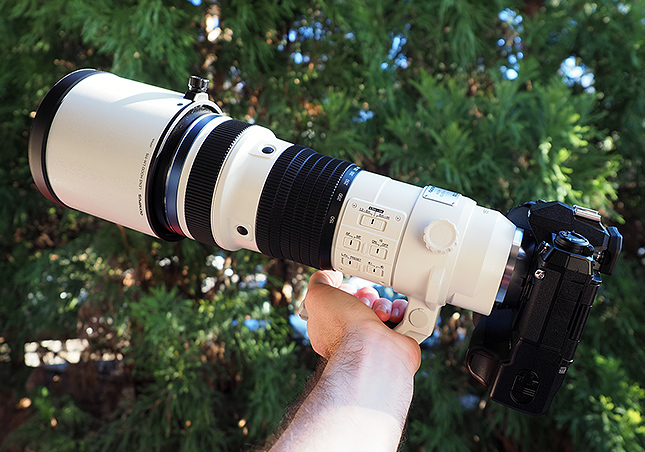 |
According to Olympus, one of the primary goals of the R&D department when developing this lens was to get it as light as possible (under 2kg) while also maintaining a rugged, durable construction. Olympus tells us that the lens barrel is constructed primarily out of magnesium alloy along with some carbon-fiber-reinforced plastic. The size advantages of the Micro Four Thirds platform, which for one thing allows for the use of smaller lens elements, allowed the engineers to use less magnesium alloy in the construction, which in turn made for a smaller and lighter lens that's still strong, solid and, of course, thoroughly weather-sealed.
Beyond just the weight of the lens, the balance is designed in such a way as to make it very easy and comfortable to use handheld. With an internally-zooming design, a carbon fiber lens hood and a very balanced optical layout, the lens is surprisingly easy to hold and use for long periods of time without a tripod or monopod. Attached to the E-M1X, the tripod foot rests comfortably in my hand, and I don't feel any sense of front-heaviness. (The tripod foot doubles as a great carry handle between shooting, with a grippy material on the top and sides.)
Despite the seemingly large and unwieldy size of the lens, I was easily able to hike around with it and use it handheld for hours without feeling much fatigue from the weight. In fact, the E-M1X setup weighs only about 6.7 pounds (including two batteries and the lens hood attached); the whole setup was light enough that my measly kitchen scale could withstand the weight. While the larger E-M1X certainly feels like the most natural and appropriate camera to pair with this larger lens, it also feels quite balanced and comfortable when used with my smaller E-M1 Mark II.
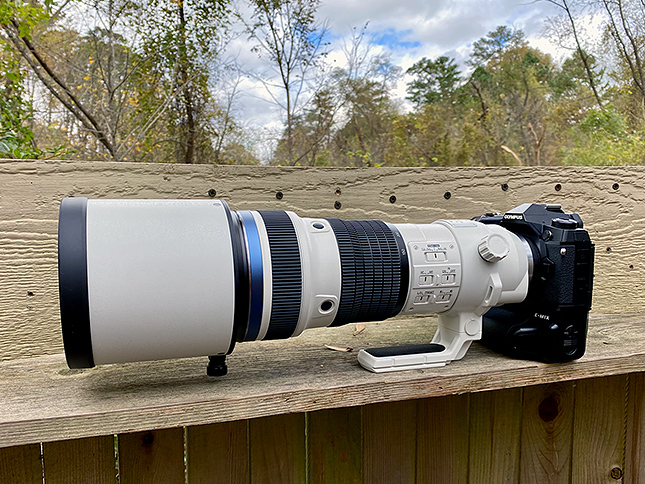 |
Now, to be fair, the 150-400mm Pro lens is a big lens. And price aside, I'd much rather carry around the comparatively tiny 300mm f/4 Pro and a couple of teleconverters. The E-M1 III and a 300mm Pro is a much more portable setup. However, it's hard not to enjoy the versatility of the zoom lens design, as well as the longer reach and built-in teleconverter. You get impressive reach and zoom flexibility without having to remove the lens and swap around teleconverters as needed. It's also worth noting that the built-in 1.25x teleconverter switch of the lens is conveniently located right next to where your hand grips the camera, and I can easily engage or disengage the built-in extender as needed with a flick of my finger -- all without taking the camera down from my eye. A nice touch.
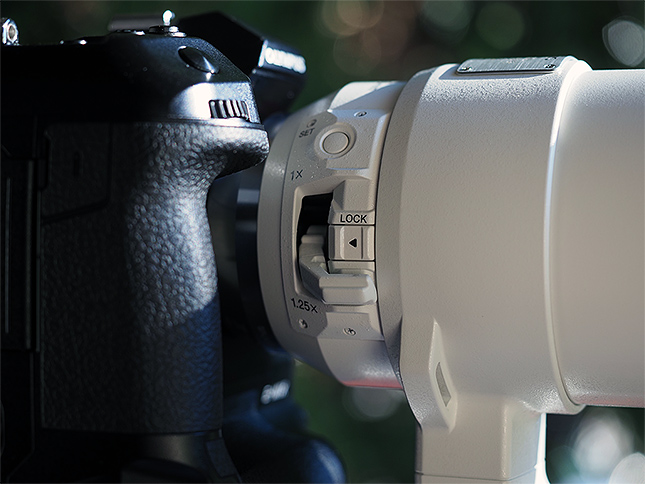 |
Right next to you hand, you have quick access to the teleconverter lever as well as the focus SET button. |
Additional Usability Details
Apart from the pleasing size and weight, the Olympus 150-400mm offers excellent functionality and usability in other areas as well. The focus ring rotates with buttery smoothness, and the zoom ring has a lightweight, easy-to-move rotational action, with about 90 degrees of rotation for the full zoom range. The zoom ring has enough resistance that you aren't likely to accidentally rotate the ring, but it's loose enough that I was able to easily zoom the lens with just two fingers while the tripod foot supported the lens in the palm of my hand.
The tripod ring and foot assembly itself is not fully removable like the tripod foot of the Olympus 300mm f/4 PRO lens. You can, however, unmount and remove the bottom foot portion if you want. The tripod foot ring unlocks and lets you rotate the lens as needed and offers detents at the four 90-deg marks, which is a handy little attention to detail.
Lastly, the lens features a panel of various switches, including an AF/MF focus switch, an I.S On/Off toggle, as well as a three-setting focusing distance limiter (1.3-6m, 6m-infinity and full 1.3 to infinity). There are also a couple of more unique switches on this control panel, one for toggling the four lens buttons between L-Fn (Lens Function Button) mode and focus Preset mode, and another switch solely dedicated for turning the "beep" off when using the Preset focus buttons (the sound toggle switch does not interact with the camera body's AF beep sound setting, however).
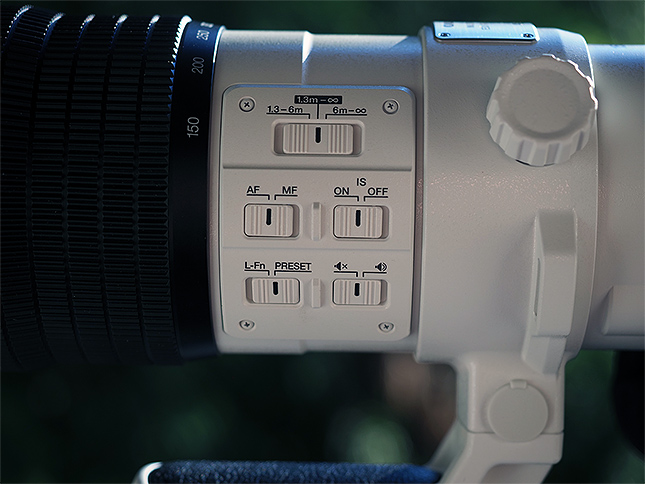 |
Like most Zuiko Pro lenses, the 150-400mm has a Lens Function (L.Fn) button, or in this case, four of them, which allows for some additional user customization for quick access to various camera settings. By default, however, these four buttons are set for AF Stop, which will temporarily halt continuous AF functionality if need be for a particular moment or composition.
I personally have not used the AF Stop feature much; however, I have made use of the Focus Preset mode for these buttons. The lens features a focus "Set" button located right above the teleconverter switch, which lets you lock-in a custom focusing distance. Once set, you can go about normal shooting, but then by pressing one of the four lens buttons on the barrel, the lens will almost instantaneously shift focus right back to that preset focus distance, likely saving you some time from having the lens rack through focus. It's quite handy with this particular lens, given the 150-400mm's impressive close-focusing distance of only 1.3 meters. This lens can focus very close for such a long lens, and while the overall AF speed is indeed fast, there's still a chance you might miss a fleeting moment of a bird landing on a distant branch, for example, while you wait for the lens to shift from a very close-focusing distance out to a further one (or vice versa). I don't use it all the time, but it's a common feature on many supertelephoto lenses, so I'm glad to see Olympus implement it here on this high-end lens.
Optical Design
When it comes to the particulars of the 150-400mm's optical layout, the lens is crammed with an impressive array of exotic lens elements. In total, the lens consists of 28 optical elements placed into 18 separate groups. The lens features a pair of HR (high-refractive) elements, one HD lens element, two ED (Extra-low Dispersion) lenses and four Super ED lens elements. The ED lens element used in the 150-400mm is larger than any ED element Olympus has designed and built in the past. All of these specialized lens elements help combat chromatic aberration and provide excellent sharpness across the full zoom range.
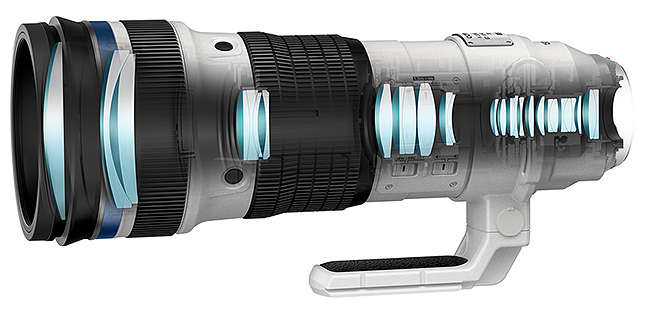 |
Additionally, the lens includes Olympus Z Coating Nano, which is a nano-sized layer of particles with a thin layer of air in the center of the surface of the lens. This coating helps create a refractive index similar to that of air, and thus reducing surface reflections from the lens elements. The lens also features a fluorine coating on the front element to help ward off dust, water and oil and makes the front element easier to keep clean.
The lens is also Olympus' first white-color lens. Other brands also often use a lighter color, as well, for supertelephoto lenses since these types of lenses are designed with much tighter optical tolerances than shorter focal length lenses. As such, thermal expansion of the lens elements due to heat from the sun, for instance, is a more noticeable issue in supertelephoto lenses. According to Olympus, the off-white coating of the 150-400mm lens is more than just a simple coat of paint, incorporating multiple layers of coatings. First, there's a base layer that helps suppress increases in internal temperature, then a heat shield layer (with a pigment that reflects infrared waves) and lastly, an overcoat layer that allows for those reflected infrared rays to escape. According to Olympus, the special lens coating helps reduce internal temperatures by about 10% and prevents externals temperature increases by about 30%.
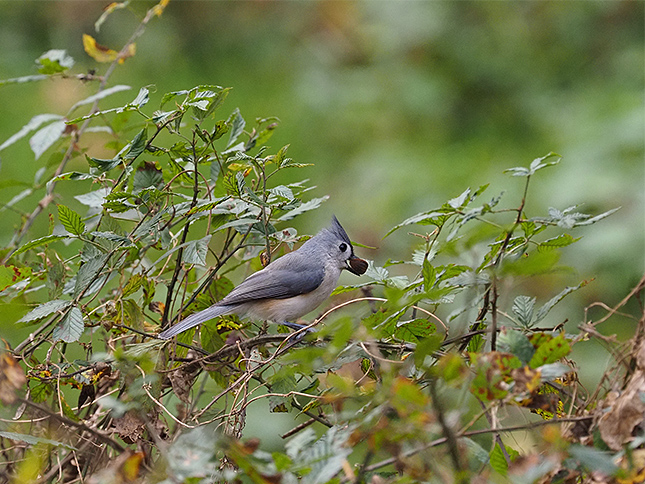 |
E-M1X: 500mm (1000mm eq.), f/7.1, 1/800s, ISO 3200, 1.25x TC (JPEG cropped slightly) |
Image Quality Performance
Much like the build quality, I am hardly surprised to find that the Olympus 150-400mm Pro lens offers outstanding image quality performance, not only due to the sheer price of the lens but also from Olympus' long history of producing tack-sharp lenses -- especially with their high-end Zuiko Pro series of lenses. Overall, there's not much to complain about or critique when it comes to image quality from this lens. The 150-400mm is tack-sharp wide-open, offers excellent sharpness across its zoom range, has little to no chromatic aberration and very minimal vignetting.
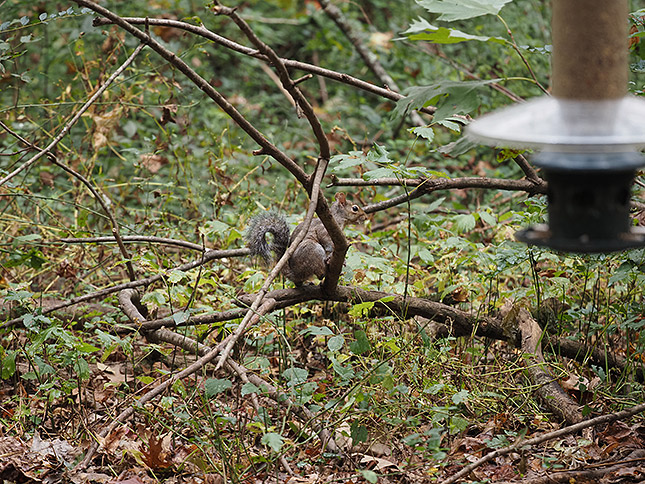 |
150mm (300mm eq.) - f/4.5, 1/250s, ISO 500 |
 |
400mm (800mm eq.) - f/4.5, 1/800s, ISO 1600 |
 |
500mm (1000mm eq.) - f/5.6, 1/1000s, ISO 3200 (1.25x TC engaged) |
(I'm surprised this squirrel sat there long enough to allow me to get this series of shots!) |
Sharpness
In the field, the Olympus 150-400mm lens is capable of capturing images with excellent fine detail and resolving power across the zoom range. I also found no issues with sharpness when shooting the lens wide open. Other top-of-the-line supertelephoto lenses are often the sharpest at their widest aperture, and the Olympus 150-400mm is no exception -- while also providing pleasing zoom versatility. Usually, all-in-one lenses or other long-zoom lenses often make some compromises on image quality in order to make a reasonably-sized or -priced lens. However, the Olympus 150-400mm Pro manages to provide both zoom versatility and excellent sharpness across its focal length range, even when used wide open.
 |
E-M1X: 375mm (751mm eq.), f/5.6, 1/800s, ISO 200, 1.25x TC |
 |
RAW crop - ACR default settings |
 |
E-M1X: 395mm (791mm eq.), f/5.6, 1/1000s, ISO 200, 1.25x TC |
 |
RAW crop - ACR default settings |
Here in the Atlanta area, most of my wildlife shooting was focused on birds -- often small songbirds -- or other small creatures. As such, I often found myself at the longer end of the lens, primarily 400mm or even 500mm f/5.6 with the 1.25x engaged. (As mentioned, I love having that teleconverter built right into the lens, letting you get just a bit more reach at the flick of a switch!) One of the benefits of this particular 400mm-reaching lens is its constant f/4.5 aperture. While not particularly bright in the grand scheme of things, it's faster and better at gathering light than Olympus' other long-zooming lens, the 100-400mm f/5-6.3 IS. With 400mm at f/4.5 or 500mm at f/5.6, I was comfortably able to keep my ISO capped at around ISO 1600-3200 for most situations and still maintain reasonably-quick shutter speeds for blur-free images.
 |
E-M1X: 500mm (1000mm eq.), f/5.6, 1/1000s, ISO 2000, 1.25x TC |
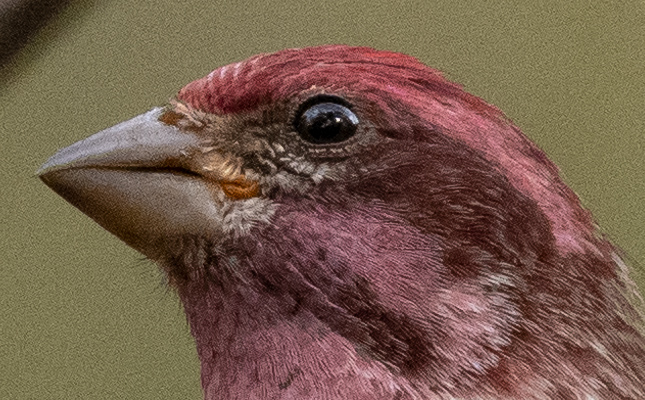 |
RAW crop - ACR default settings |
However, even with this reasonably-bright aperture (which is fairly on par with competing supertelephoto lenses), I still often required higher ISOs, since I was either shooting in cloudy conditions or under the shade of a forested area. Thankfully, the E-M1X easily handles ISO 3200, and with this sharp 150-400mm lens, I was still able to capture crisp photos of birds and other wildlife with excellent fine-detail in the birds' feathers and animals' fur.
 |
E-M1X: 500mm (1000mm eq.), f/5.6, 1/1000s, ISO 2500, 1.25x TC |
 |
RAW crop - ACR default settings |
In our review of Olympus's standalone MC-14 1.4x teleconverter, we found that adding this extender caused very minimal degradation to overall image quality. Our sharpness analysis showed a slight decrease in sharpness, but real-world images still contain fantastic sharpness and detail. Similarly, the built-in 1.25x teleconverter of the 150-400mm Pro lens is also excellent. Though based solely on real-world images, I noticed little to no drop in image quality when shooting with the TC engaged. As with other teleconverters, you lose some light-gathering performance, in this case going from an f/4.5 lens to f/5.6.
As I've said, having the built-in extender is very convenient, but what if you need even more reach? Amazingly, the 150-400mm is also compatible with the MC-14 and MC-20 teleconverters. Mounting the 2x teleconverter and engaging the built-in 1.25x extender gives you a hand-holdable telephoto lens with a 2000mm-equivalent focal length. That is insane!
In terms of image quality with the combined 2x TC and 1.25x, this pairing drops the maximum aperture of the lens all the way down to f/11. That's not ideal. For one thing, you've severely limited in your light-gathering potential, and unless you're in good lighting, you'll certainly be in a balancing act of ISO sensitivity and shutter speed in order to capture sharp, blur-free images. I'll touch on the image stabilization further down, but the IS of this camera and lens worked fantastically, allowing me to capture sharp photos without needing to crank up the ISO to super-high levels.
Secondly, at f/11, you're hitting into the realm of diffraction-related softness for this sensor type. With the Four Thirds sensor size, we've often noticed subtle diffraction-related softness begin to creep in even at f/8. However, to my eye, I was still impressed with the image quality at f/11 with this double-teleconverter setup. While there is likely some loss of detail and contrast, I didn't observe a significant drop to image quality when pairing up the 2x TC. To my eye, the image quality is more than good enough -- if you're able to frame and focus at such a long focal length!
 |
E-M1X: 585mm (1172mm eq.), f/11, 1/1250s, ISO 3200, 1.25x TC + MC-20 2x |
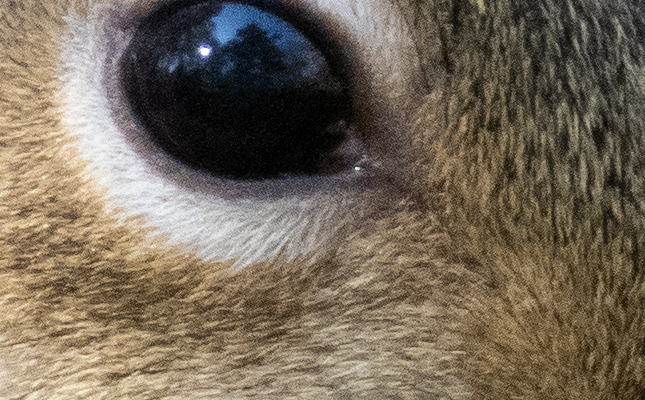 |
RAW crop - ACR default settings |
In terms of diffraction with the lens itself, the 150-400mm does quite well. Sharpness is great in the center (at 150mm and 400mm) all the way up until f/11, with minimal loss of sharpness as you stop down. It's only until about f/16-f/22 that diffraction-related softness becomes noticeable, and even at that point, it's far from a severe loss in sharpness.
Corner sharpness is also quite impressive, even wide open. At 150mm, the lens is excellent at both the centers and out at the corners, wide open. Stopping down to f/8 had little effect in increasing the sharpness of the already-great corners. At 400mm, however, I did notice some slight corner softness at f/4.5, but this was only after taking some careful test images. In standard real-world shooting, I didn't observe any issues with corner sharpness at the longer focal lengths. However, given this type of lens, the vast majority of my real-world images had sharp, isolated subjects with deeply blurred backgrounds, and as such, corner sharpness was of little concern. That being said, stopping down at 400mm does help sharpen up the corners ever so slightly. But again, much like diffraction, corner softness at 400mm f/4.5 is still very minimal, at least to my eye.
Chromatic Aberration & Vignetting
In terms of chromatic aberration and vignetting, the lens passes with flying colors in both areas. Chromatic aberration is barely noticeable, if at all, even along high-contrast edges, such as back-lit tree branches and edges of leaves. Vignetting, meanwhile, is present, but it's extremely minimal. It's most apparent at f/4.5 at both 150mm and 400mm, but stopping down a bit will clear up the mild corner shading. Said another way, do not worry about both CA and vignetting with this lens.
 |
 |
150mm f/4.5 |
150mm f/8 |
 |
 |
250mm f/4.5 |
250mm f/8 |
 |
 |
300mm f/4.5 |
300mm f/8 |
 |
 |
500mm f/5.6 (1.25x TC) |
500mm f/8 (1.25x TC) |
Image Stabilization
Another factor in both image quality performance and overall usability is the 150-400mm's excellent 5-axis Sync I.S.-compatible image stabilization system. Given the long focal length range of this lens itself, not to mention the extreme reaches you can get when using various combinations of teleconverters, having image stabilization is basically a must-have for using this lens handheld. Fortunately, this is Olympus we're dealing with here, a company with stellar image stabilization technology. Needless to say, I.S. works great with this lens!
Like the 300mm f/4 Pro and the recent 100-400mm zoom, the new 150-400mm f/4.5 Pro lens is one of the few M.Zuiko lenses to feature onboard optical image stabilization that works in conjunction with OM-D cameras' in-body image stabilization system. On its own, the optical IS of the lens is rated for 4.5 stops of stabilization, which isn't all that bad. However, when paired with either the E-M1X or E-M1 Mark III, Olympus claims that the combined 5-axis Sync IS system can provide up to 8 stops of stabilization at 150mm (300mm eq) or 6 stops at 500mm (1000mm eq. -- 400mm + 1.25x TC).
Image Stabilization Specs (CIPA ratings):
- Lens IS
- 4.5 stops
- 5-axis Sync IS (E-M1X and E-M1 Mark III)
- 8 stops at 150mm (without built-in teleconverter)
- 6 stops at 400mm and 500mm with built-in teleconverter
- 5-axis Sync IS with MC-2x TC attached
- 7 stops at 300mm (without built-in teleconverter)
- 5 stops at 1000m (with built-in teleconverter)
 |
E-M1X: 220mm (441mm eq.), f/4.5, 1/400s, ISO 250 |
It should be noted that these Sync IS ratings are only with the two latest-generation OM-D cameras, the E-M1X and E-M1 III. Olympus did not provide an I.S. rating when using earlier cameras, such as the E-M1 Mark II. Sync IS will work when using the 150-400mm with the E-M1 II, for instance, but one should not expect I.S. performance to be as powerful with this older camera. The E-M1X and E-M1 III both have newer, more advanced gyro sensors in their IBIS systems, which allow for improved stabilization performance.
In the field, I certainly appreciated the image stabilization system. At these incredibly long focal lengths, vibrations and camera movements are amplified. The I.S. system worked very well to help steady the view through the EVF, allowing me to concentrate on focusing and composition. That said, it can still be quite tricky to maintain a smooth, steady view. It's particularly noticeable with the 2x TC attached, as you're dealing with a 2000mm-equivalent field of view; I definitely found myself struggling somewhat to keep things smooth and steady while maintaining my focus point on a small, distant subject at this focal length.
However, for the most part, the image stabilization system was very impressive. Most of the time, I never "thought" about the I.S. system nor thought about what my shutter speed was. I was just concentrating on focusing, framing and getting my shots. The majority of my shooting was done in Aperture Priority mode, with the lens and camera calculating an appropriately fast shutter speed to allow for a sharp image. It was only after the fact, while browsing through my images, that I noticed just how slow the shutter speed could get despite the long focal length, yet still come away with a crisp shot. I was very impressed.
While I wouldn't consider this example image below "good" from an artistic standpoint, the fact that I was able to get a sharp, blur-free image at 400mm (800mm eq) with a shutter of just 1/80s handheld is incredible.
 |
E-M1X: 400mm (800mm eq.), f/8, 1/80s, ISO 3200 |
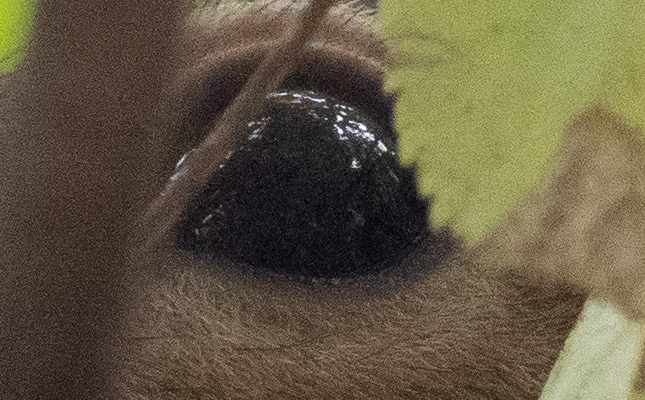 |
RAW crop - ACR default settings |
Similarly, here's a handheld 1000mm (2000mm eq) image with a shutter speed of just 1/250s!
 |
E-M1X: 1000mm (2000mm eq.), f/11, 1/250s, ISO 3200, 1.25x TC + MC-20 2x |
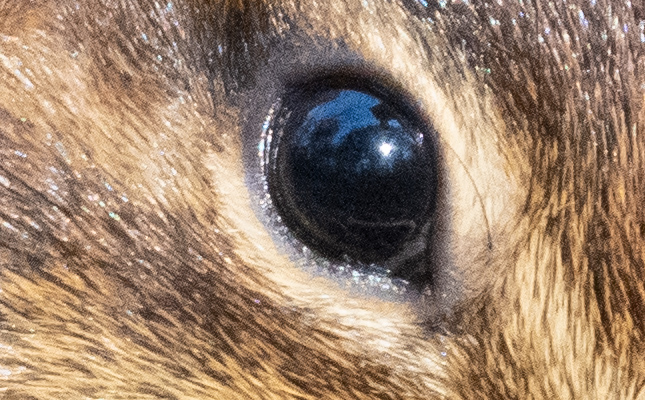 |
RAW crop - ACR default settings |
RAW crop - ACR default settings |
Focusing Operation
When it comes to autofocus, the 150-400mm Pro offers very fast autofocusing performance as well as impressive close-focusing capabilities, despite its long focal length range. The 150-400mm can focus down to just 1.3 meters, or about 51 inches, and that's at focal lengths and with teleconverters, too. By comparison, the 150-400mm Pro focuses closer than the 300mm f/4 Pro (1.4m) and closer than the Canon 200-400mm f/4L (2m) and the Nikon 180-400mm f/4E (2m), for example. On its own, the 150-400mm offers a 0.5x magnification ratio at 150mm and 1.14x at 400mm (in 35mm equivalent terms). With the 1.25x TC engaged, the magnification increases to 0.62x (short) and 1.43x (long) in 35mm eq.
 |
E-M1X: 400mm (800mm eq.), f/4.5, 1/800s, ISO 1250 |
In sheer focusing speed, the 150-400mm is incredibility swift, with Olympus telling us that this lens offers faster focusing performance than the 300mm f/4 Pro. The lens is designed in such a way that the focusing group of this lens is only comprised of a group of two small, lightweight lens elements. As such, there's very little mass to move back and forth, making for very quick and precise AF speeds in most situations. Given the close-focusing distance of the lens (1.3m), there's quite a distance to cover when racking focus from minimum focus to infinity and vice versa. However, it only takes about a second to rack from near to infinity focus and vice-versa, which is very quick.
One thing that the 150-400mm Pro lacks is any form of focus distance scale. Unlike most other Zuiko Pro lenses, the 150-400mm lacks the usual AF/MF Focus Clutch mechanism, that for one thing, reveals a focusing scale. There's no window or display on the lens to give you a focusing distance. However, with the upcoming firmware v2.0 for the E-M1X and v1.2 for the E-M1 III, Olympus is adding an on-screen focusing distance graphic. It won't provide discrete distance measurement but will provide some estimated scale for focusing distance.
 |
E-M1X: 445mm (891mm eq.), f/5.6, 1/800s, ISO 1600, 1.25x TC |
In the field, I never ran into any focus issues, for the most part. In most situations, especially when making small focus distance changes, AF speed felt nearly instantaneous. Focus tracking also felt quick, precise and accurate. The only "hiccup" I experienced was managing the sheer range of focusing distance that this lens can cover. As mentioned, the 150-400mm can focus down to just 1.3 meters, and as such, it can sometimes be tricky to quickly transition from focusing on a distance subject and suddenly wanting to focus on something up close. It's definitely worthwhile to make use of the Focus Preset function as well as the Focus Limiter switch to rein in the focusing distance for the subjects you're trying to photograph.
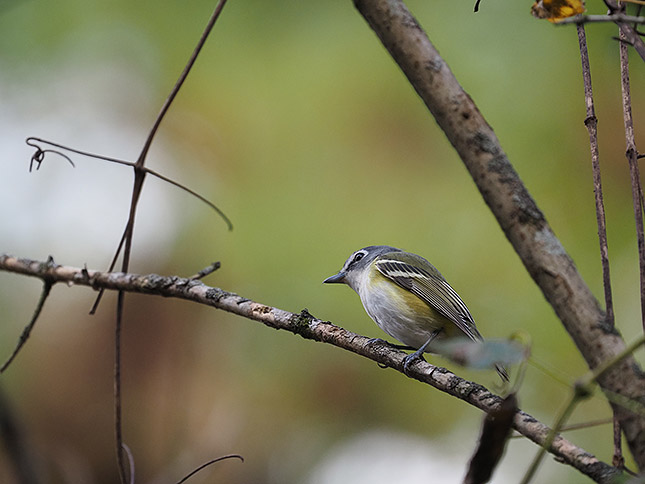 |
E-M1X: 473mm (947mm eq.), f/5.6, 1/1000s, ISO 1250, 1.25x TC |
Summary
So, how to sum-up one of Olympus' most impressive lenses? If you're a serious wildlife photographer and can afford it, get it.
Price aside, the Olympus 150-400mm f/4.5 IS Pro is an incredible lens for nature and wildlife photographers. The image quality is fantastic, offering tack-sharp performance across the zoom range, with or without its built-in teleconverter. AF is also spot on and very fast, and the incredible close-focusing distance provides even more versatility, allowing for nice close-up performance that's atypical of super-telephoto lenses.
In terms of the overall build quality, the lens is, as expected, built like a tank, even if it is surprisingly light. The lens feels incredibly solid and very well built, as one would expect from a $7,500 piece of optical equipment.
In the end, yes, the Olympus 150-400mm f/4.5 IS Pro very expensive in and of itself, but it's also very, very good. Lenses for serious wildlife photography are often quite pricey and are a serious investment, and the Olympus 150-400mm is no exception. However, when compared to several of its full-frame counterparts, the 150-400mm Pro is both reasonably priced and incredibly versatile. If you want to slim-down your wildlife gear, and free yourself from tripods and monopods, the lightweight Olympus 150-400mm Pro lens is worth serious consideration.
 |
E-M1X: 168mm (337mm eq.), f/4.5, 1/400s, ISO 320, -0.3EV
|
Pricing & Availability
The Olympus M.Zuiko Digital ED 150-400mm F4.5 TC1.25x IS PRO lens comes packaged with the LH-115 lens hood, CSS-P121 lens strap, LC-115 lens cap and LSC-1642 lens case. It is available for pre-order now for $7,499.99 USD and $9,999.99 CAD and will begin shipping in late January 2021.
Zuiko PRF-ZD95 PRO Protection Filter (sold separately) This protection filter features ZERO Coating to suppress flares and ghosts from reflections and easy-to-clean, fluorine-coated, black-edged glass. The filter features a satin, glare-reducing black aluminum frame. MSRP: $324.99 (US)/$429.99 (CAD)
Olympus 150-400mm f/4.5 TC1.25x IS PRO M.Zuiko
Your purchases support this site
Micro Four Thirds
Olympus 150-400mm f/4.5 TC1.25x IS PRO M.Zuiko User Reviews
The Olympus 150-400mm f/4.5 TC1.25x IS PRO M.Zuiko doesn't have any user reviews yet!